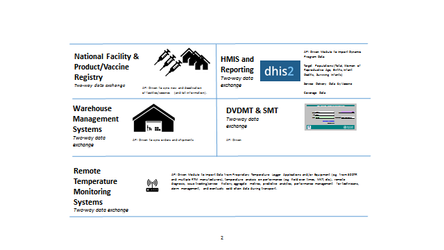Feedback for GAVI check list
Initial feedback for the detailed feature list that the committee provided was discussed on the May 23 2017 meeting.
Second round of feedback is on the following presentation on the high-level overview of what electronic vaccine LMIS should include. The presentation should be reviewed as the overview to the detailed checklist (we reviewed earlier), meaning that after each slide there would be a reference to the detailed features.
Please insert your feedback on each slide below:
Ian is looking for insight into the level of detail and overall approach to the higher-level view. Some of the slides are still a work in progress and are missing details for the intermediate store(s).
Slide 1: Configuration
- On the Facility and Product pieces, we have heard a desire that LMIS integrate with national registries. An idea would be to call that out here or in the interoperability slide.
Slide 2: Transactions
- Mary Jo: I suggest providing more description or a label for the red arrows pointing to the right. They could represent an 'allocation' or 'fulfillment' to a requisition.
- Chris Wright: I agree with Mary Jo, but would go one step further. We need both allocation and requisition represented, and they are essential, not option.
Slide 3: Analytics
- Mary Jo: I suggest changing this to forecasting specifically since I think you are trying to describe the desire to create different formulas based on the various data elements. The next slide on reports will cover the key reports.
- Chris George : Maybe similar to Mary Jo's note, but I notice in the more detailed checklist, DISC indicators are really on referenced from a summary report perspective, and so it makes sense for them to show up in the reports slide (as they do). If this slide is more for forecasting, could make a more high level reference to the DISC indicators contributing to forecasting, if that is the intent of placing them in this slide as well.
- Chris Wright: Is it the intent for this slide to align the data/KPIs to the tier? It implies that most data are at central level, but CCE data are at facility level. Some DISC indicators should be visible and used at lower tiers, too.
Slide 4: Reports and Alerts
- Chris George : Could be misreading this, but it seems that we are grouping the 'Vaccines / Dry Goods' reports / alerts under the central level, while the CCE reports / alerts sit under the service delivery point - I was thinking many of these reports are cross-cutting from central all the way down to the HF, particularly on the 'Vaccines / Dry Goods' reports / alerts (e.g. low stock). Maybe this is showing where the user of the report would reside - central vs. service delivery point?
- Chris Wright: My comment from the last slide (3) pertains to this, too. Having the tiers at the top of the slide implies that the data elements below "belong" to that tier. If that isn't the intent, I'd remove the tiers above or stretch arrows horizontally from teh data element through the applicable tiers.
Slide 5: Interoperability Layers
- Chris George : I think to not confuse from the use of the top level picture of 'central', 'intermediate', and 'service delivery site' in the other slides, could get rid of this diagram here - I was just worried the viewer might be inclined to group the below items up to a specific level as was done in the previous slides, even though interoperability is more cross-cutting through the whole system.
- Chris Wright: Should we also include interoperability with a WMS/ERP in situations where the eLMIS manages stock at lower levels but not at central?
- Mary Jo: I’d suggest renaming the slide to “eLMIS Interoperability”. I think the word layer may be confusing since sometimes the “layer” may be outside of the eLMIS solution itself. I’d focus on the eLMIS must provide ways to be interoperable with the following systems. I’d also suggest that eLMIS can “push”/export data into the WHO DVDMT and SMT since that is the desired use case. For WMS, I’d suggest two way interoperability/integration so that orders can be sent to WMS and shipment information can be received. You could even through in a syncing of product lists (or a nationally maintained product list or GDSN). I’d suggest adding another system, a national facility registry. For example, clearly breaking out the different types of systems which it would be ideal for LMIS to interoperate with. I agree it is confusing to make these generalized statements given the detailed nature of each integration and at what level.
OpenLMIS: the global initiative for powerful LMIS software
